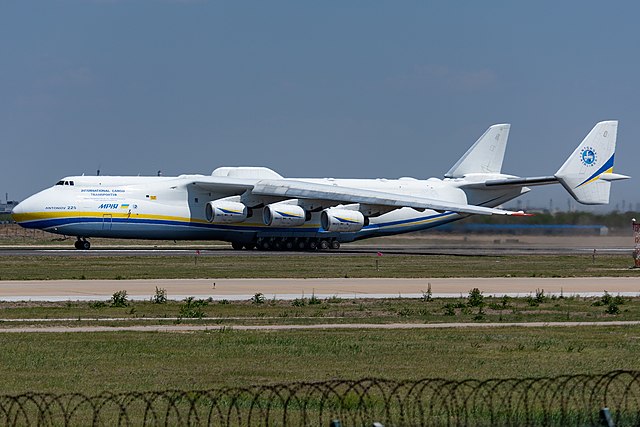
How big could a plane or helicopter be? Theoretically, there is no limit so long as there is a strong enough material and enough thrust can be produced. Practically, there are no materials strong enough to make planes or helicopters much larger than they already are.
The largest helicopter in the world at the moment is the Russian Mil V-12. It was developed in the 1960s and only two of them were built. They were both retired in the 1970s and they can both be found on display in Moscow. The Mil V-12 is 37 m long, which is just over half the length of a 747. They have wings and a wingspan of 67 m. They have a maximum takeoff weight of 105 tons, which is about 25% of a 747. Because they are so large, they need to have two sets of rotors, one set on each wing, to provide enough lift. The helicopters were built to lift intercontinental ballistic missiles, but they ended up not being used at all.
The largest plane in the world is also Russian. It is the Antonov An-225 Mriya. Only one plane was ever built and it was finished in 1988. It only flew for a few years and was retired in the early 1990s. There was talk about using the plane again, but it never happened. The An-225 was parked at an airport near Kyiv, Ukraine, where it was rather ironically destroyed by the Russians when they invaded Ukraine in 2022. The plane was 84 m long, 13 m longer than a 747. It has a maximum takeoff weight of 640 tons, which is 200 tons more than a 747. The plane had 6 engines and 32 wheels.
So, how big could a plane or a helicopter be? Well, planes are bigger than helicopters and whatever size they can be built to, a plane will probably always be larger than a helicopter. There are several reasons for this. The first is that helicopters are powered by rotor blades, and there is only so much thrust that they can provide. Just as a propeller airplane will never be as fast as a jet plane, helicopters will only ever be able to produce so much thrust. The second reason is the downforce. When a helicopter is lifted up by its rotors, the rotors push air down, which is called downwash. When the Mil V-12 helicopter was hovering close to the ground, its downwash could knock over people, vehicles, and even small buildings. Any larger helicopter that was constructed would have to find a way to deal with the downwash.
If companies are going to make larger planes, there are several things that they need to consider. They will need stronger and lighter materials. They will need more powerful engines. They will need to redesign the airports. They will need to think if it is commercially worth it.
The first consideration must be the materials. As a plane gets larger, there is more weight that needs to be lifted into the air. The problem is that this weight is not supported equally, but held up by the wings, which puts a lot of structural force on those areas. Designers spread the load out through the plane as much as possible using beams, but there is still a lot of force on the wings. If a plane gets larger, it also gets heavier, and there are more forces on the wings. That would have to be spread out, but those supports make the plane heavier, and it becomes a spiral of weight. The only realistic way to make a plane bigger is to make it out of stronger and lighter material that can easily support the weight without any strain and is so light that it doesn’t add to the weight of the plane much.
The engines will need to be more powerful because a plane can only fly if its thrust can exceed its weight and the drag on it. Even if a new, lighter material is invented, a larger plane will still be significantly heavier and will need more thrust.
Another practical problem is the size of airports and runways. They are designed to cope with the planes we currently have and there are many runways that even a 747 can’t use. A bigger plane would not be able to land anywhere without altering all of the runways. That is, assuming new technology enables planes to take off and land in shorter distances. If that were to happen, then current runways would be sufficient. Although, the long wingspan of new planes might prove a problem.
And the last thing is whether or not this is a commercially good idea. It would cost an enormous amount of money to make a plane larger than the current largest plane and any company that builds one would have to be sure that they could sell enough of them to make their money back. There are not many airlines that need a plane so large and there are not many airline routes where shipping far more passengers or cargo at once would be an advantage. It is probably cheaper to send several small planes than one giant plane. The carbon footprint must also be considered as well.
One place where there aren’t any restrictions on the size of a plane would be in space. If we start traveling through space, the zero gravity would allow us to make any size space planes that we needed. I think that might not happen in my lifetime though. And this is what I learned today.
Image By N509FZ – Own work, CC BY-SA 4.0, https://commons.wikimedia.org/w/index.php?curid=89497371
Sources
https://www.quora.com/How-large-can-a-helicopter-theoretically-get-Is-there-a-maximum-possible-size
https://en.wikipedia.org/wiki/Antonov_An-225_Mriya
https://en.wikipedia.org/wiki/Mil_V-12
https://aviation.stackexchange.com/questions/27401/is-there-a-maximum-possible-size-for-an-airplane
